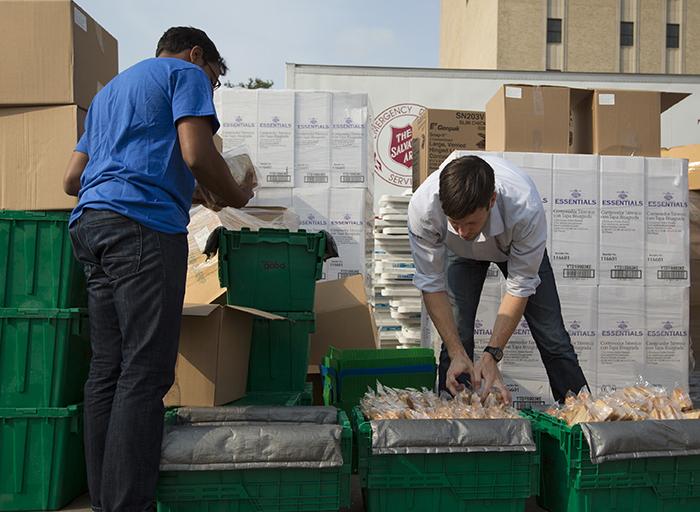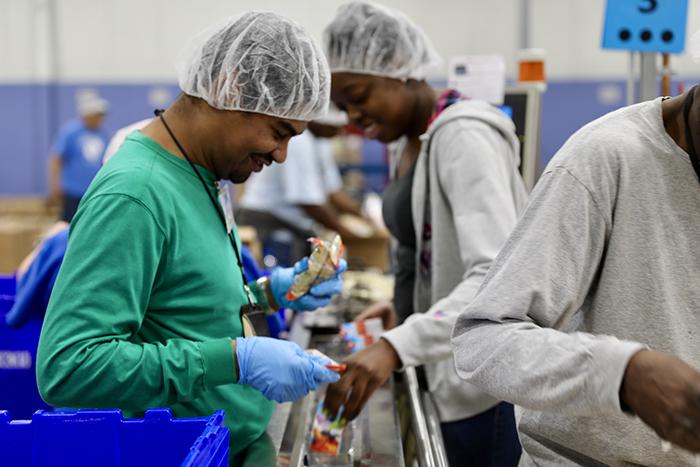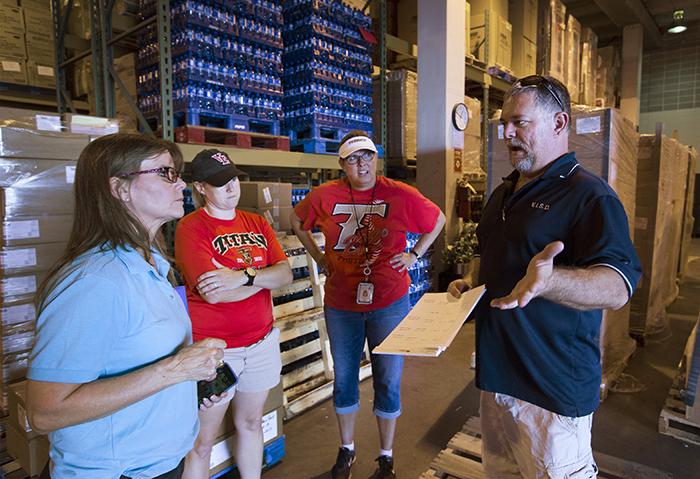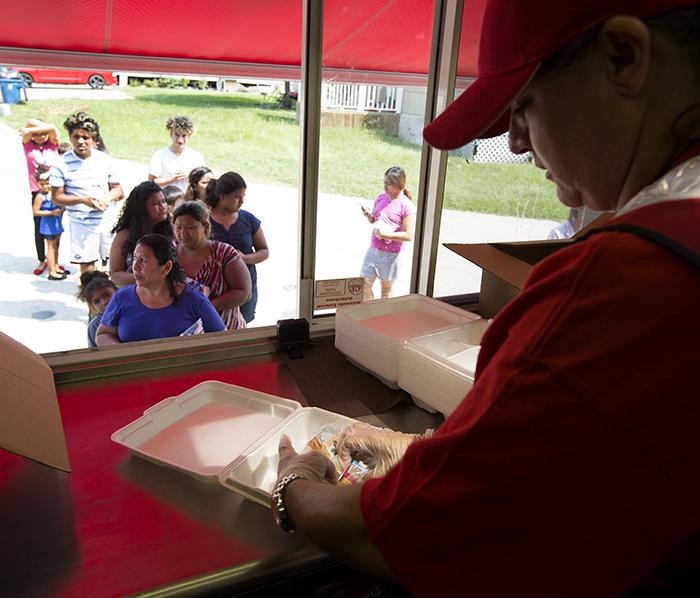PepsiCo Is Serving 1 Million Meals to Hurricane Victims. Here’s How They Made It Happen
by Beatriz Terrazas
PepsiCo Is Serving 1 Million Meals to Hurricane Victims. Here’s How They Made I…
A Salvation Army truck pulled into the mobile home park at 520 Gulf Bank Rd. in Houston on the Wednesday after Labor Day. Situated in the Halls Bayou watershed, this community was hard-hit by Hurricane Harvey. The water had receded, but cleanup was just beginning. The streets were lined with piles of debris residents had pulled from water-damaged homes: sodden carpeting, warped headboards, water-logged mattresses, the odd couch, and plastic bags bulging with trash.
Minutes after the truck’s arrival, kids and moms began trickling over. They wore what they’d salvaged—shorts, t-shirts, tennis shoes, sandals. One woman was barefoot—“The flood took my shoes,” she said.
In the truck, a volunteer assembled boxed lunches. Another brought out snacks to offer the kids while they waited. The children didn’t know that the food delivery was the result of a herculean effort by PepsiCo partners in a commitment to feed people after Harvey’s devastation in Southeast Texas. They didn’t know that this was just the beginning of PepsiCo’s effort; they were among the first to receive these meals. The kids just knew they were hungry. And food had arrived.
One million meals
After Hurricane Harvey hit, the PepsiCo Foundation committed a $1 million donation to the American Red Cross for relief efforts. But was there more they could do?
In Plano, Texas, the week before Labor Day, PepsiCo’s Food for Good director Matthew Smith took a call from Frito Lay’s president and COO, Vivek Sankaran.
“He said, ‘Hey, we want to do more to help the relief effort and we know Food for Good operates in Houston and we would love to partner together to do more,’” Smith recalls. “We talked to the various partners and put together a number and we said we could do 25,000 meals a day for 30 days.” That “stretch plan” would total 750,000 meals. Sue Norton, Vice President of the PepsiCo Foundation, came back with another idea: How about an even million meals over 40-60 days?
Food for Good, PepsiCo’s break-even business, feeds low-income children through after-school, weekend and summer programs in nine states and 18 cities, including Houston. Since 2009 the company has delivered nearly 16 million meals (or 65 million healthy servings) as of September 2017. Committing to spearhead the food delivery for Harvey-affected Texans would fall outside of this regular effort.
But Smith has three kids of his own—eight, six and two years old. He also has family in Houston, including his father, who is in a wheelchair. His family was spared Harvey’s wrath but had gone through the same fear of those now suffering loss of family and property.
“To know the fear of not being able to evacuate and having young kids and folks with disabilities and then to lose everything—” he says, “—I’m deeply passionate about being able to serve families in that situation.”
A million meals? Doable. With the PepsiCo Foundation donating $1.75 million in meal costs, Smith’s Food for Good team began putting plans in place so deliveries could begin just after Labor Day to Houston area shelters and affected communities.
A special opportunity
Meanwhile 1,500 miles away, at Wisconsin’s Milwaukee Center For Independence (MCFI), about 100 adult clients with special needs have been working with Food for Good for a year as part of a job-training program. They typically package small runs of shelf-stable K-12 school meals for MCFI and local clients.
But when Heidi Chada, MCFI’s vice president of employment and commercial services, got the call about cranking up production to contribute 500,000 shelf-stable meals over a month’s time, she saw it as a special opportunity.
“This project is exceptionally valuable to our clients,” says Chada. “They knew they were packaging for hurricane victims, kids, families, adults who don’t have electricity, going through a tough time.”
MCFI clients work production from 8 a.m. to 3 p.m. Monday through Friday. But there weren’t enough of them to run the lines outside those hours so the company sought volunteers to ramp up production, says Chada.
Before Labor Day rolled around, they’d managed to produce about 30,000 meals that would go to hard-hit and hungry storm survivors in Texas. By the time the holiday weekend was over, MCFI had about 30 volunteers committed to working evenings, nights and Saturday.
“We’re going to do our best to get as many of those million meals packaged,” says Chada.
The first meals arrive
Victoria, Texas, about 120 miles southwest of Houston, has a population just shy of 93,000. According to Census data, almost 90 percent are Hispanic. Here, Harvey damaged roofs, gym floors, and cut off power to all the school buildings. Several families lost their homes entirely. As of Labor Day, two schools still lacked power and repairs were ongoing. Officials hoped to get kids back in school by mid-September.
Tuesday after Labor Day dawned hot and muggy, with passing clouds providing little shade. Outside the Victoria ISD food commissary, cars began pulling up and dropping off teens in groups of twos and threes. They were athletes from East and West High Schools, mostly girls. More than 40 of them had volunteered to receive Food for Good’s first shipment of meals —some 30,000. The students would distribute them over the coming days, for as long as they lasted, while school kitchens came back on line to prepare hot meals for families.
“We have 24 schools and 14,000 students, slightly over that,” says Dana Bigham, director of child nutrition for the district. “About 65 percent of the kids in the district receive free or reduced school lunches,” she says, “so a lot of our families that lost everything, they’re in dire need. So we’re just trying to help them out.”
“It was very sudden.”
Back at the mobile home park in Houston, families waited in the Salvation Army truck line. One boy held a squirming black puppy, and other family dogs hung around, perhaps waiting for scraps. Finally, it was time for lunch. Kids and adults received a turkey sandwich, along with pretzels, applesauce, other snacks, and a juice box.
Among the mothers picking up food was Mari Rodriguez, a wife and mother of three. Rodriguez had lived here for two years before Harvey hit the Texas Gulf Coast.
“We got out Sunday morning, when it was the worst of the flooding,” she said. “It wasn’t raining hard enough for that magnitude of water, but I guess a break in the gates elsewhere caused this water to come down here. It was very sudden.”
When the family left, the water hadn’t reached her home’s floor, but in parts of the neighborhood, the water was chest-high. Neighbors in boats carried her children to higher ground. “They were taking us to the nearest school, and from there, there was a bus to take us to a shelter.”
Five days later, she returned to find her home was fine, but the family cars were ruined from having been under water and her neighbors lost “almost everything” in their home. She’s been home for less than a week now, and unable to leave the mobile home park.
“We are so grateful for the help,” she said of the meals provided that day. “Our cars are broken. We have no way of getting out to look for groceries. … My children are happy.”
As people drifted away with food, a cloud of dust lifted nearby. Three men had parked a truck next to a dumpster and stirred up the air, tossing away pieces of a family member’s life: wood paneling, sheetrock and carpet remnants. On another street, a child rode a bike while a teen girl and a woman lugged large planks out of their home. More than 10 days after Hurricane Harvey had come ashore, much work still lay ahead.
Here's how you can help. Contact these organizations:
American Red Cross, www.redcross.org, 1-800-HELP NOW
The Salvation Army, www.salvationarmyusa.org, 1-800-SALARMY
Feeding America, www.feedingamerica.org






